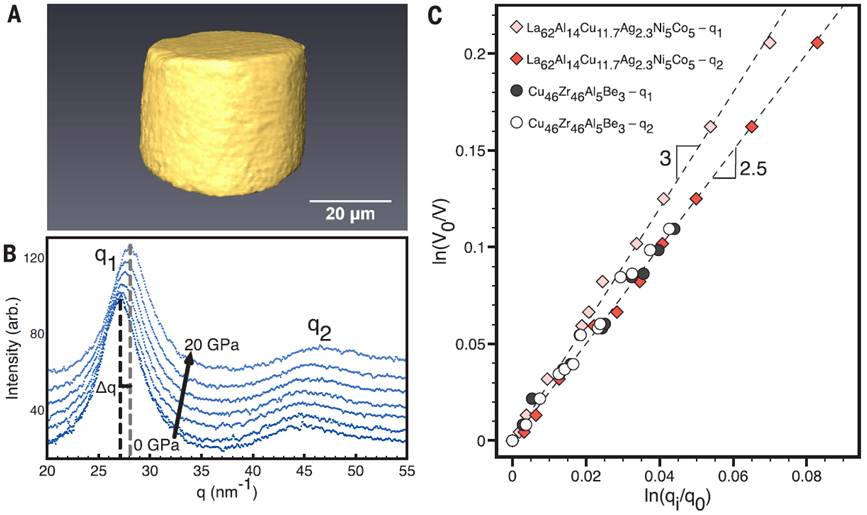Metallic glass: homogenous in appearance, fractal at heart - Dr. Qiaoshi Zeng & Dr. Wendy Mao
SEPTEMBER 18, 2015
The atomic structure of glasses has been a long-standing unsolved mystery in condensed mater physics and materials science. A breakthrough in understanding the atomic structure of an important new category of glass — metallic glasses was made by a joint research team including staff scientists of HPSTAR, Dr. Qiaoshi Zeng and Dr. Wendy L. Mao. From multiple techniques, the team found a specific fractal model — the percolation cluster packing could provide a perfect explanation of the 2.5 power law observed in the compression experiments of metallic glasses and a unified description of the atomic structure of metallic glasses from short range to macroscopic length scale for the first time. These results are just published by Science (DOI: 10.1126/science.aab1233).
In general, the melt of any substance can be frozen into a disordered solid called glass if cooled rapidly enough. Metallic glass was born in 1960s by melt quenching, which retains the non-directional metallic bonding compared to the conventional crystalline metals but lack regular atomic packingand the associated typical defects, such as dislocations and grain boundaries. Metallic glasses thus display many unique properties combining extremely high strength, high hardness, good wear resistance, high corrosion resistance and etc. They have attracted substantial research efforts for decades, which aimed to probe the structure, properties and the underpinning factors controlling glass formation. However, the understanding about the atomic structure of metallic glass is still limited to very local length scale. How the local clusters extend to efficiently fill up the three dimensional space without crystalline symmetry yet remains elusive.
Recent high pressure study on metallic glasses by Dr. Qiaoshi Zeng et al., revealed a non-cubic 2.5 power law scaling of the sample volume with respect to the first diffraction peak position [Zeng et al. PRL 112,185502(2014)]. The universality of the 2.5 power law in the structure-properties relationship of metallic glasses strongly suggests a common fractal feature of their structure. However, it is well known that the fractal structure usually involves macroscopic voids and pores as the length scale becomes large which is therefore thought to be unlikely to describe the densely packed structure of metallic glasses.
Following the discovery of 2.5 power law, the team continually found a specific class of fractal, the continum percolation cluster with the fractal dimension of ~ 2.52 for metallic glasses in the present work. This model avoids introducing macroscopic voids and pores by limiting the fractal structure within a finite correlation length. On the length scale above this correlation length, the system is homogeneous. That means there is a power law exponent crossover from 2.5 to 3 when the length scale increases across the correlation length. The researchers utilized in-situ high pressure x-ray diffraction,tomography measurements as well as molecular dynamics simulations on several different metallic glass materials, repeatedly confirmed the existence of this crossover and the continuum percolation cluster model for metallic glasses.

Caption: (A) Three-dimensional reconstructed sample volumes from in-situ high pressure transmission x-ray microscopy data at ~0 GPa. (B) in-situ high pressure x-ray diffraction data with increasing pressure from ~0 GPa to 20 GPa. (C) Volume scaling with scattering vectors q1 and q2 for Cu46Zr46Al5Be3 and La62Al14Cu11.7Ag2.3Ni5Co5 metallic glasses.
“This finding of the percolation cluster model was inspired by the exactness of the 2.5 power law discovered in high pressure experiments and simulations.This model offers us a unified description for the metallic glass structure from local length scale to macroscopic scale. This has never been achieved before,” said Qiaoshi Zeng, “we expect it will have important implications for understanding a wide range of questions in metallic glasses including glass transition, crystallization, deformation mechanism and etc.”
This work received support from the National Natural Science Foundation of China (grant U1530402). The paper’s other authors are David Z. Chen, Qi An, William A. Goddard III and Julia R. Greer of California Institute of Technology, Crystal Y. Shi of Stanford University.
